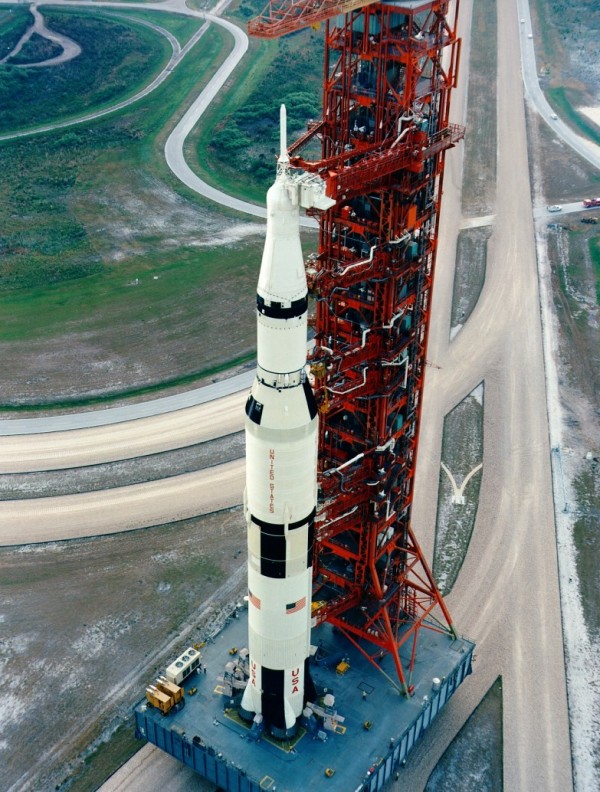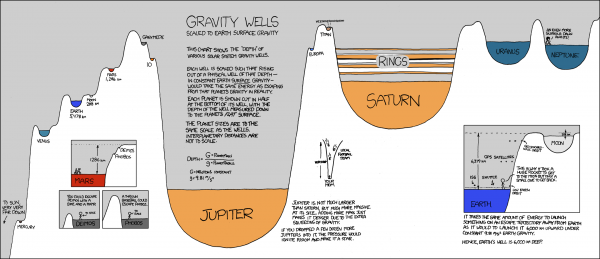Watch me as I gravitate (hahahahaha). -Gorillaz
Gravity -- unbelievably -- is the weakest force of all. But if you get enough mass together, gravity will overwhelm even the strongest outside influence. A simple case-in-point? You take a rock that's massive enough, and gravity will crush it into a spherical shape,

like it was nothing more than a drop of water.

And here we live on the surface of one of the smaller gravity balls in our Solar System. XKCD has a wonderful illustration of this today (and click for full-size).
The more massive and more compact your planet is, the harder it is to get off of. Something like the Moon, which is only about 1.2% of the mass of the Earth but 27% of the Earth's radius, is way, way easier to escape from than the Earth. To escape from the Earth's gravity, you need to reach a speed of 40,000 km/hr (25,000 mph) from the Earth's surface. To escape from the Moon, on the other hand, you only need to reach 8,600 km/hr (5,400 mph). This is why, to go from the Earth to the Moon, you need a rocket like this:

But to go from the Moon back to the Earth, you only need a rocket like this:

(For those of you who are physics buffs, remember that energy goes as velocity squared, which means that if you need five times the speed, you actually need 25 times the Energy!)
This is one of the biggest arguments in favor of a one-way mission to Mars. To get to Mars from the Earth requires about the same rocket power as it takes to get to the Moon. However, to get back to Earth would require an escape velocity of 18,000 km/hr (11,200 mph), which means something far more powerful than we needed on the Moon; something like this:
That's right, we'd need to build a major launch site on Mars just to return to Earth. I'm not saying that doesn't mean we shouldn't do it, but if we require it, it's going to be that much longer (and more expensive) before we get to go to Mars.
The Martian Moons, on the other hand? We could get back -- in theory -- with one of these.

So choose your planetary targets carefully, if you ever want to come back!



"one-way mission to Mars" That phrase just makes my skin crawl.......
You have a photo of the LEM. The trans Earth Injection was carried out by the Apollo Service Module
http://www.worldofenergy.com.au/graphics/photos/factsheet15/apolloSpace…
I think one way is a great idea. I doubt you'd have a hard time finding people who'd be willing to go. Humans are explorers. We could start establishing permanent settlements and, over time, build up the launch facility to make a return possible. Plus it'd be freaking cool...
Even if it's one-way as in suicidal, I bet NASA wouldn't have trouble finding a crew. Mars is calling for us in a big, big way and I think many believe the knowledge and progress that could be gained from a manned mission is worth the cost in lives.
The problem with that, is they might have trouble acquiring the funding to send suicidal people to Mars.
Forget the pogo stick, let's just build a rocket out of soup cans.
The comparison of rocket sizes to get to and back from the moon isn't really accurate, because a lot of the capacity of the Saturn V was needed to launch the lunar return vehicles - the LEM to land & return to orbit, and the Service Module to brake into lunar orbit and then depart that orbit for Earth return.
COMMANDER KEEN!!!
Fly Drone Dirigibles from Mars Orbit<\Bold><\H1>
It seems to me that the way to visit Mars and return is to not go down to the surface. But, it also seems kind of boring to go all that way just to drop another crawling robot to look at a few square meters of territory. What we need is a collapse-able dirigible that could be dropped into the Martian atmosphere with heat tiles and stuff (like the shuttle) and then inflated from canisters to a lighter-than-Mars-air configuration that would allow remote controlled flight. Use solar-electric power for the buoyancy control compressors and the propeller.
Such a device could be equipped with sufficient telemetry to provide a "presence" for the pilot and other investigators nearby in orbit. The small communications delay in such close proximity would allow much more maneuverability than devices piloted from Earth. Such a thing could even land, take off again, land again; you get it. The remote pilots could take a good look at everything.
Maybe a second mission could drop a vehicle designed to transport samples back up to orbit. Drop it empty since the dirigible will bring back stuff to fill it up with. That way we could get samples of stuff from all over Mars back to one launch vehicle that could get back up to orbit with a small payload.
A key mission would be to locate a good site for human explorers to make a landing. Whoever landed would need water to make fuel and they would need a good cave to live in out of the radiation.
Maybe the cave could be made air tight and pressurized to provide for more comfortable living? Inflatable domes could be used to grow stuff in if organic fertilizers were also brought along. All depending on water of course. If the dirigible is properly equipped, the landing party could fly it around too, looking for more water and stuff.
If the landing party is going to get back into orbit to be picked up for eventual return to Earth, the mission would require about 10 visits from Earth ships dropping all the materials that would be required to build the launcher and launch vehicle. That process would take about 20 years, so be sure to send a young landing party. Make the landing party co-ed in case things don't work out on the first try. Subsequent generations might make it up to orbit.
While the landing party is busy, might as well build a space station in orbit around Mars and have somebody stay there all the time remotely flying the dirigible around. Should be looking for caves and water, valuable mineral deposits, signs of life, anything commercial that might pay for the trip. Especially, make films to sell to Nova which will also help pay for the trip.
Most importantly, this mission should not be done on the cheap. Everything should be massively redundant. We have all seen those movies where one thing breaks and then nobody can get home again. None of the devices on this mission should have a "destroy all humans" mode.
1) A fun physics estimation problem related to the intro paragraph: calculate the largest size object that can be highly nonspherical. Using iron's yield strength and density you find a size (which I don't remember offhand) that's somewhere between your typical asteroid and all the planets in our solar system.
2) I like the one-way trip to Mars ideas. Most historical exploration attempts turned into suicide missions; why not embrace the idea? I'd rather go on a one-way suicide mission with a high probability of success than a round-trip mission with a lower probability of making it to Mars (due to all the additional complications of trying to be able to return). But maybe I'm just a weirdo.
Of course, I believe it's much better to send robots on one-way suicide trips to Mars than ANY sort of human mission. Not only are the robots much cheaper, but a robot mission seems less likely to contaminate the planet with earth life than a human mission. This could be important if we're interested in looking for evidence of (past?) life on Mars.
yeah, but what if robots conquer the mars and make their own colony there?
Better yet, stay the hell away from Mars. Deimos, OK, but better Ceres and Vesta. There might actually be something useful on, or in, those.
Mars? Another word for nuisance.
The idea of using wings and propellers on Mars is a non starter. Mars athmosphere is so thin it could not support flight of any kind, or even more worringly, hold back meteorites.
Commander Keen!!! Woot!
One way to Mars? The North Pole is more hospitable, and you can get back from there. Northern Siberia, the bottom of the ocean...
Humans are going to remain 'stuck' on this island paradise planet of ours for quite some time. We need to embrace that thought. We live or die right here.
But robotic exploration of the cosmos is really cool. What it teaches us about us more than pays for itself.
If the question is 100 robot missions or one human mission, I'll vote for the robots without hesitation. There are many places in the solar system that present tantalizing questions that robots can answer. I agree with Jodie, no matter what we better make sure we take care of earth.
Hi!, I'm Tim It would be so cool to travel to mars and set up wells to pump up water to get plants going in large greenhouses. Trees,Vegtables,ect!in turn would give off more and more o2.And better yet,Eat up a big amount of carbon dioxide!And the best part,About the whole trip would be my new way of getting lare amounts of water back on the planet!! What's really got me scraching my head is why nasa has not thought of it already?I have a real,tangiable idea! Something that can only work!No second guesses,No testing this or that,My idea just works!We could have the planet mostly able to sustane life within 5 years at best!! Tim
@9 Mars has notoriously awful sandstorm accompanied by extremely high winds. Don't know that the dirigible would work and also the thin atmosphere would be the primary issue. Great idea though.
@17 You make it sound so easy and only 5 years for life sustainability. Why wait 5 years when we can just go into the martian mines with Arnold Schwarzenegger and have him activate the aliens hidden ice cap melters. This way we'd have an atmosphere suited for life in 35 seconds flat and he could be the 1st governor of mars.
Isaaic Asimov said in his book (The Collapsing Universe) that the closer the the center of gravity you are the stronger the pull of that gravity is. He also said that if you were to dig a hole very close to the center of the earth, that gravity would not be stronger b/c the mass that was pulling on you b/f u dug the hole is now no longer below you; therefore your standing on top of less matter and its gravity is now subtracted from the total net gravitational pull (in essence your closer to the center of gravity, but you have removed the matter to get there so u don't feel its effects below you any longer). So even getting closer to the center of the earth by digging a hole will not increase the gravitational pull if u dig your way there.
So if I dig a huge hole and set up a launch facility, will it take the same amount of energy to escape the gravity as it would if you did not dig the hole and just blasted off from earths surface?
Thanks for the correction!
(and for someone who occasionally relies on meter, a word like "aren't" is a right pain, with a portion of one's readership thinking it is wrong either way.)i-tunes download